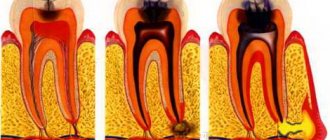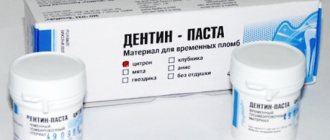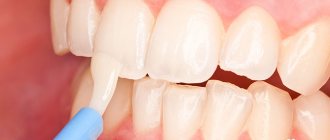Indications for placing a temporary filling
- Treatment of deep caries. After cleansing the tooth cavity from necrotic masses, the dentist places a medicinal solution that helps the dentin strengthen the layer between the pulp chamber and the open cavity.
- Diagnosis of the condition of the tooth with deep caries before installing a permanent filling.
- Acute pulpitis. A temporary intermediate composition is placed while the nerve is removed.
- Periodontitis. To relieve inflammation, an antiseptic or medicinal preparation is placed in the area of the tooth roots, which is then covered with light cement.
- Sanitation of dental canals before filling. The doctor cleans the canals, filling them with a disinfectant solution, then places a temporary filling.
- Prosthetics, restoration. The process of making an artificial crown or orthodontic structure takes several days. To protect against microbes, the open tooth cavity is closed with a temporary filling material.
Stages of placing a temporary filling:
- opening the tooth cavity, removing all affected dentin tissue;
- expansion, cleaning, treatment of dental canals;
- therapeutic stage (depending on the diagnosis, the nerve endings of the pulp are removed, medications are placed in the tooth cavity, and the canals are filled with temporary cement);
- The crown is closed with a temporary filling.
Possible complications after tooth filling
Most often, patients complain that the filled tooth continues to hurt under the installed filling. If we are talking about the first hours after filling (maximum - up to a day), this can be considered normal. If the tooth continues to hurt for the second day, this may be a sign of a medical error, for example, poor quality of treatment of a carious cavity before placing filling material in it. In this case, you need to go to the dental clinic, get examined, and take an x-ray. Treatment may need to be repeated.
Another common reason for visiting a doctor is a filling that has fallen out. If this happens after several years, it is possible that the filling has simply expired and needs to be replaced. A filling that is not replaced in time can actually fall out. The doctor will determine the reason - either the warranty period has expired and the tooth was not treated in a timely manner, or new caries has formed. If a fresh, recently placed filling falls out, we can confidently speak of a medical error.
Material of manufacture
Requirements for temporary filling materials:
- no toxic effect on tooth structures (enamel, dentin, pulp) and mucous membranes of the oral cavity;
- safety for human health;
- chemical inertness and high resistance to saliva and aggressive environments (alkalies, acids);
- mechanical strength, wear resistance, ductility;
- lack of galvanization effect;
- maintaining shape and size during hardening;
- good radiopacity.
The choice of material for a temporary filling depends on the clinical case, age, individual characteristics of the body (the presence of allergies to certain substances), as well as how long the patient will wear it.
Choosing temporary filling material: proceed without mistakes
Every practicing dentist knows how important the correct selection of filling material is for effective treatment. Modern dentistry offers a huge selection of materials, which are divided into classifications depending on composition, properties, time of use, purpose, etc. A fairly large place among them is occupied by a group of filling materials for temporary fillings, as well as insulating and therapeutic pads.
Materials for temporary fillings
Based on the time of action, they are divided into bandages and temporary fillings. Inexpensive materials are used for dressings. The most common option: water-based dentin or dentin-paste. The period of use of these materials should not exceed 14 days. At the same time, the bandages do not differ in aesthetics and durability. All temporary fillings are cements : zinc phosphate, zinc eugenol, polycarboxylate, glass ionomer, etc. The period of their use in the patient’s oral cavity ranges from several weeks to six months.
1) Zinc sulfate cements (“artificial dentin”)
The main components of the composition are zinc sulfate and zinc oxide. Adding water helps the mass harden. The most famous materials of this group: “Dentin for dressings”, Dentine paste, Vinoxol, etc.
2) Zinc-eugenol cements
The basis of the composition is zinc oxide and eugenol. According to Smith's classification (1996), this subgroup includes three main types of cements: simple zinc oxide eugenol; reinforced zinc oxide eugenol with filler and cements based on orthoethoxybenzoic acid (EBA). The materials consist of zinc oxide powder, into which 1-2% zinc acetate, acetic anhydride or rosin are added, which accelerate hardening. Purified eugenol or clove oil is used as a solvent. Additionally, to speed up the hardening process of cement, acetic acid or 1% ethyl alcohol, as well as a small amount of water, can sometimes be added. The most popular representative of this group is Cariosan. Zinc-eugenol cements are used not only for temporary fillings , but also for therapeutic linings. It is important to take into account that eugenol disrupts the polymerization process of composites, so experts do not recommend using this type of cement in combination with them. That is why today zinc-eugenol cements are practically not used for therapeutic linings in commercial clinics, but they are still in demand in pediatric dentistry and in municipal clinics for the treatment of deep caries in two visits.
3) Zinc phosphate cements
75-90% of the cement base is zinc oxide with the addition of other modifying oxides. The liquid part is an aqueous solution of 38-44% orthophosphoric acid containing phosphates of zinc, aluminum, magnesium, etc. Among the most famous zinc-phosphate cements presented on the Russian market are: Phosphate cement from Raduga-R, Uniface ( “Medpolymer”), Adgesor (“Dental Spofa”), DeTreyZinc from “DeTrey/Dentsply”, etc. As a rule, metals containing silver are added to these compositions to impart a bactericidal effect. As an example, we can o), Phosphate with silver and bactericidal Foscin (“Rainbow-R”), as well as cements containing bismuth oxides: Visphate cement and Dioxyphosphate (Medpolymer).
The undoubted positive properties of these cements are: ease of use, low thermal conductivity, good X-ray contrast, and impermeability to acids and monomers. However, they have quite a lot of negative characteristics. Among them: weak adhesion, low resistance to the aggressive effects of saliva, shrinkage, low mechanical strength, the presence of free acid and lack of aesthetics.
Most often, zinc-phosphate cements are used as an insulating spacer for filling baby teeth and permanent crowns, fixing cast stump inlays, pins, crowns and bridges.
4) Polycarboxylate cements
The basis of cement is thermochemically treated zinc oxide with the addition of magnesium oxide, which reduces the reactivity of the first component. Aluminum is also often added to powders. The solvent is represented by a 32-42% aqueous solution of polyacrylic acid. During the hardening process, cement turns into an amorphous zinc-polyacrylate gel, which contains zinc oxide particles.
The positive properties of these cements include: satisfactory chemical adhesion to enamel and dentin, strong bond with metals, weak toxicity to the pulp compared to phosphate cement and high biocompatibility with tooth tissues. Negative properties: high solubility under the influence of saliva, short formation time in the oral cavity and insufficient fluoride adhesion.
Polycarboxylate cements are used as insulating spacers when filling teeth under artificial crowns, for fixing orthopedic and orthodontic structures, and in the treatment of baby teeth (1-2 years before their replacement).
All materials for temporary fillings must be:
- harmless to the pulp;
- have high plasticity;
- inactive for other drugs;
- insoluble under the influence of saliva;
- sealed for at least two weeks;
- have a certain strength;
- easily removed from the dental cavity using an excavator, probe or drilling.
Insulating and healing pads
The purpose of these materials follows from their name. Despite the fact that they can be conditionally classified as filling materials, the application of gaskets is an integral step in the treatment of medium and deep caries. spacers when treating medium and deep caries . They contain calcium hydroxide, which has an anti-inflammatory effect on the pulp and stimulates the deposition of replacement dentin. Among the most popular materials are: “Calmecin”, “Dycal”, “Calcimol” and “Alcaliner”, as well as modern insulating gaskets made from glass ionomer cements, such as: “Fuji 2”, “Chelon Fil”, “Base Line” and etc.
Today the following requirements apply to insulating gaskets:
- reliably protect dentin from chemical and temperature irritants;
- easy to install;
- withstand the effects of saliva when the filling is damaged;
- withstand chewing load;
- have good adhesion to tooth tissues;
- do not have an aggressive effect on the dental pulp;
- do not affect the color of tooth enamel.
Therapeutic pads have an anti-inflammatory, regenerating and analgesic effect, therefore they are used in the treatment of deep caries. They are characterized by good ductility, the material hardens quickly. Basically, the therapeutic component of modern medical pads is calcium hydroxide, which has a bactericidal effect and shifts the pH environment in the tooth cavity to the alkaline side, which ensures neutralization of acids. The base material can be polymer, water-based, oil-based or monomeric. Dentists use either ready-made medicinal pads or prepare them themselves. The use of a therapeutic pad significantly reduces the risk of the formation of microcracks and the development of secondary caries. However, with all their advantages and positive effects on the pulp, these compositions have noticeable disadvantages:
- low adhesion to dentin, which determines the weak adhesion of the filling to the tooth tissues;
- lack of resistance to the aggressive effects of saliva, which creates conditions for further infection;
- accidental contact of gasket particles with the walls of the formed cavity can lead to secondary caries.
It is recommended to apply therapeutic pads in cases where the bottom of the formed cavity is located too close to the pulp. It is believed that in order to prevent infection of the pulp by toxins, the minimum thickness of the dentin layer should be 2 mm. When placed correctly, the therapeutic material completely covers the bottom of the carious cavity or lies pointwise in the areas where the pulp horns adjoin. In this case, it is necessary to carefully remove it from the walls of the cavity in order to avoid disruption of the adhesion of the filling material and the development of secondary caries.
Regardless of their purpose, all temporary filling materials must meet the same clinical requirements:
- do not have a toxic effect on the enamel, dentin and pulp of the tooth, as well as mucous membranes;
- be harmless to the body as a whole;
- have antiseptic, anti-inflammatory and anti-caries effects;
- be chemically inert and resistant to aggressive environments such as alkalis and acids;
- have sufficient adhesion to dental tissues, mechanical strength and wear resistance;
- do not change the color of the tooth and do not lose its original color over time;
- do not cause the appearance of galvanic currents in the oral cavity;
- do not change shape and volume during hardening;
- have good radiopacity.
For an experienced specialist, purchasing filling material, like any other dental consumable, usually does not cause any particular difficulties. However, the dental market, being one of the most dynamic and rapidly developing areas of global business, is constantly changing, which makes it difficult to keep track of new products and truly profitable offers in a timely manner. Today, the marketplace of the Internet portal “Dentists Club” is rightfully considered one of the most reliable and positively proven resources. This aggregator has been successfully operating in the dental market since 2017 and has already proven itself as a proven and honest partner. At the same time, the Dentist Club market is the only aggregator of offers in the field of dentistry today, which allows you not only to purchase the necessary goods at the guaranteed best prices, but also in addition to receive a cashback of 1.5% back to your account!
What other benefits does the Dentist Club market provide?
1. Time saving
- You don’t need to go to all the search results sites to find what you need
- There is no need to call companies and try to explain to them over the phone what you need
- No need to send a request and wait for managers of trading companies to answer or call you back
2. The Dentist Club Market service helps when communicating with doctors
- You can easily find the desired product by description and photo
- Determine the desired model and its modification
- Check all these parameters directly with your doctor and get his approval
- Place an order in one click.
3. Lowest prices on the market guaranteed
- You can simultaneously see the prices of all companies offering the required product
- Compare the prices presented and choose the most profitable one
- The manager of the selected company will call you back. He doesn’t need to explain ten times what you need, because... He sees all the necessary information in the generated order.
- And don't forget about cashback!
4. 100% order security
- Absolutely all companies - suppliers of dental equipment and consumables, collaborating with the marketplace, have already been checked for legal purity by lawyers of the Dentists Club. That is why all purchases made on the Dentists Club market are absolutely reliable!
5. Ease of use
- You can install the Dentist Club Market service on your phone so that it is always at hand. Open the app, find the products you need, and order. Everything is quick, accessible and simple. Application in the App Store on iPhone (iOS) or on Google Play for Android.
Aida Levasheva – senior nurse at the dental clinic (Samara):
“To be honest, purchasing dental supplies was my least favorite job until recently. I do not have a dental education, and until recently this created certain difficulties. Of course, before purchasing, I asked doctors what material was more convenient for them to work with. The problem was that everyone had their own preferences. I had to search for what I needed all over the Internet, compare prices, and call managers of trading companies for half a day to find out the terms of payment and delivery. This often took almost the entire working day. And in the end, the head physician, looking at the list and prices, crossed out half of the points. The Dentist Club Market was recommended to me by one of my classmates at medical school. I really liked the resource. For me, the most important thing is a very convenient and simple interface, which you can easily understand even without a dental education. I especially liked the function where you can compare prices for the desired product! If you need professional advice, you can get it directly on the website and immediately pay for your order there. All this is very convenient and saves a lot of time!”
Go to Market >>>
Intermediate filling materials
- A paste based on zinc sulfate and kaolin allows you to restore the crown of the tooth.
- Karyosan has an analgesic and antiseptic effect.
- Vinoxol is an artificial dentin. Withstands chewing load for up to 1-2 months.
- Cement with zinc and eugenol. It is used for antiseptic treatment of tooth tissue and relief of the inflammatory process.
- Glass ionomer cement is used for temporary fixation of the prosthesis.
- One-component polymer materials are pastes with a viscous consistency that harden under the light of a special lamp.
Permanent filling material
The materials used to make dental fillings for permanent use vary. Many of those that dentists previously used for fillings have fallen out of use. Metal alloys have ceased to be used due to their increased thermal conductivity and the ability to lead to overheating of the pulp. Gone are also some types of plastics that turned out to be toxic or not durable enough. Dentists refused cementation, since this method poorly reproduced the density and color of natural teeth, in addition, cement required serious grinding of entire tooth tissues.
Today, teeth are filled with composite materials, which are divided into chemical and light. Hardening of a chemical filling occurs due to a corresponding chemical reaction, and a light filling hardens when illuminated with blue light emitted by a special lamp.
How long does it take to wear a temporary filling?
Depending on the material of manufacture, a temporary filling has different characteristics of strength and tightness and can last from several days to six months.
Average duration of use of a temporary filling:
- 2-3 days, if a drug is placed under the filling that destroys the nerve endings of the pulp;
- 7–10 days while treatment of the inflammatory process with periodontitis or pulpitis continues;
- 2-3 weeks - for the period of manufacture of the orthopedic structure;
- several months in special diagnostic cases (when treating a dental cyst, restoring dentin after deep caries).
It is necessary to strictly adhere to the timing of wearing temporary fillings. If the time period is extended, its integrity and sealing may be compromised, which will negatively affect the health of the tooth. Thus, arsenic-based paste, if not removed after 2-3 days, begins to penetrate the dentin through the tubules, destroying bone tissue.
How long a temporary filling can be worn is decided by the attending physician, depending on the diagnosis and the chosen treatment method.
Removing a temporary filling is a mandatory procedure before placing a permanent filling. After removal of the temporary composite, antiseptic treatment of the root canals and dental cavity is carried out. Next, a permanent filling is installed.
Filling care
There is no need to take special care of fillings, at least no more than the teeth themselves. Teeth with and without fillings should be brushed regularly, at least twice a day, thoroughly removing plaque and food debris. It is worth visiting the dentist approximately every six months for preventative oral hygiene. During this procedure, existing fillings will be polished and carefully inspected.
Do not forget that the material for filling teeth is more porous than tooth enamel, so the filling can change its color under the influence of coloring drinks or foods. For the first time after caries treatment, you should not eat red berries, beets and other foods, especially if your front teeth are filled.
Problems that arise when installing a temporary filling
Painful sensations can be caused by an incompletely destroyed nerve, infection under the filling, or the development of inflammation.
The filling falls out or crumbles. If you do not immediately consult a dentist, the treatment will have to begin again with re-sanitation of the canals, treating them with antiseptics to stop the development of infection.
An unpleasant taste in the mouth often indicates depressurization of the temporary coating, when the medicine from the tooth begins to leak into the oral cavity.
Darkening of the filling, swelling or redness of the gums may be signs of an allergic reaction to a component of the filling material.
Material requirements
To install a temporary filling, a specialized material is used that can be easily removed by the dentist if necessary. The composition for temporary filling must meet the following requirements:
- X-ray resistant. To check the correctness of the filling, the dentist prescribes an x-ray examination. The image allows you to timely identify the presence of cracks in the filling material and eliminate them.
- Good grip on the surface. It is necessary to exclude the formation of microcracks or incomplete adhesion of the material to the tooth tissue. Violation of this rule may result in medication entering the oral cavity.
- Elasticity. The material should easily fill the pores formed in the tooth tissue.
- Strength. The material is installed by the dentist for a certain period of time. When eating, the filling is subjected to high stress. In this regard, the seal must be resistant to mechanical damage.
- Harmlessness. The filling should not cause allergic reactions or negatively affect human health.
- Easy to remove. At your follow-up appointment, the doctor quickly removes the temporary filling.
A mandatory requirement for temporary material is a high curing speed. The filling completely hardens in 2 – 3 hours.
What problems may arise that will shorten the wearing period?
Lost temporary filling
After installing a temporary filling, the following problems may occur:
- pain associated with infection of the cavity or incompletely killed pulp;
- crumbling and loss of filling material;
- the presence in the mouth of a sharp specific smell that even interrupts the taste of food;
- formation of dark spots on the tooth;
- swelling of the gums, often accompanied by a stench.
If you have one of the listed symptoms (for example, if a filling has fallen out and the tooth hurts), you should immediately consult your doctor. The consequences of deformation of the filling or undetected problems with the tooth can provoke complications and, as a result, additional costs for treatment.
To prevent deformation and loss of the filling material, it is recommended to exclude rough and solid foods from the diet while wearing the temporary filling, and also clean the oral cavity twice a day with toothpaste and a brush.
Temporary filling hurts when pressed: how to cope with the disease?
People often ask the question: “if you have a temporary filling installed and your tooth hurts, what should you do?” When a tooth hurts under a temporary filling, this is a normal condition, do not panic. If the dentist said that there is no cause for concern, you should be patient and wait out the unpleasant symptom. When a temporary filling causes severe pain in a tooth, and you run out of strength to endure the pain, you can use the following recommendations:
- rinse your mouth with antiseptic and soothing solutions. You can prepare them yourself at home from natural ingredients. For example, chamomile and sage are poured with boiling water and the resulting product is used to rinse the mouth;
- do not allow food and drinks (mainly hot or cold) to come into contact with the treated tooth;
- take a painkiller (analgesic). “Nise” and “Ketorol” give good results;
- make lotions with valerian tincture. A moistened cotton swab of valerian is applied to the painful area, the gum near the tooth. This will temporarily relieve the irritation.
If a tooth hurts after installing a temporary filling and swelling or redness of the soft tissue appears, this may indicate the presence of an inflammatory process or the appearance of pus. In such a situation, you should re-make an appointment with a dentist-therapist. The A-Medic clinic employs qualified specialists with extensive experience. To make an appointment, just fill out the standard form on the official website of the clinic (indicating your full name and contact number). Prices are affordable, and consultation with a dentist is completely free.
What is the difference between a temporary filling and a permanent one?
The obvious main difference is the length of time the filling is used. If a permanent filling is placed, on average, for 5 years, then a temporary filling is placed for a period strictly determined by the doctor. It can be several days or a couple of months.
This leads to the following difference between permanent and temporary fillings - they do not need such durability. Temporary options are made from less durable materials, because they will not have to experience heavy loads for a long time.
It is logical to assume that permanent fillings are more expensive. This is true. They are made from more expensive materials, so the price for such fillings will be higher.
If the doctor necessarily offers the client a choice of material for a permanent filling, then with a temporary filling it is not so simple - sometimes the dentist will voice his choice or several proposals, but more often he makes the choice himself, without consulting the patient.
Removal and replacement for permanent
Removing the temporary plug is a mandatory procedure before installing a permanent structure. Usually removal is done after the end of treatment, removal of the nerve, so it does not cause pain. There may be slight discomfort, but it goes away after a couple of minutes.
After removing the filling, the dentist must clean the root canals and treat the tooth with an antiseptic. After all measures have been taken, the tooth can be considered ready for permanent filling.
Which filling is better?
Given the variety of filling materials, their different characteristics and the need to match the filling to the individual characteristics of the patient, it is obvious that only a doctor can make the best choice. But the patient has the right to take part in the selection of fillings, weighing the pros and cons of each type of material, focusing on its cost. It is necessary to take into account the possible negative consequences of your choice if you refuse the material strongly recommended by the dentist, since only a doctor can correctly assess all the features of the treatment. Trust your dentist!
How much does a filling cost?
Before answering this question, you need to understand what is included in the price. Before placing a filling, the doctor must remove tissue damaged by caries, fill it with filling material, grind and polish the restored tooth. In most cases, the cost of a filling is included in the price for caries treatment, which averages from 1,000 to 3,000 rubles in economy class clinics (although in some price lists you can find prices starting from 500 rubles), it will cost from 4,000 rubles treatment of caries and installation of a light filling in business-class dentists and from 6,000 rubles in premium clinics and VIP dentists in Moscow.
Drugs placed under a sealed barrier
The service life of the temporary plug initially depends on the drug put into it:
- Arsenic is used to kill the nerve in the tooth for subsequent depulpation. For this purpose, a number of other toxic substances are used, which help not only to painlessly remove the nerve, but also to subject the entire pulp tissue to necrosis;
- To treat periodontitis or pulpitis, antiseptics or antibiotics are used to relieve inflammation. Such a filling is usually worn for about 20 days until the infection is completely suppressed.











